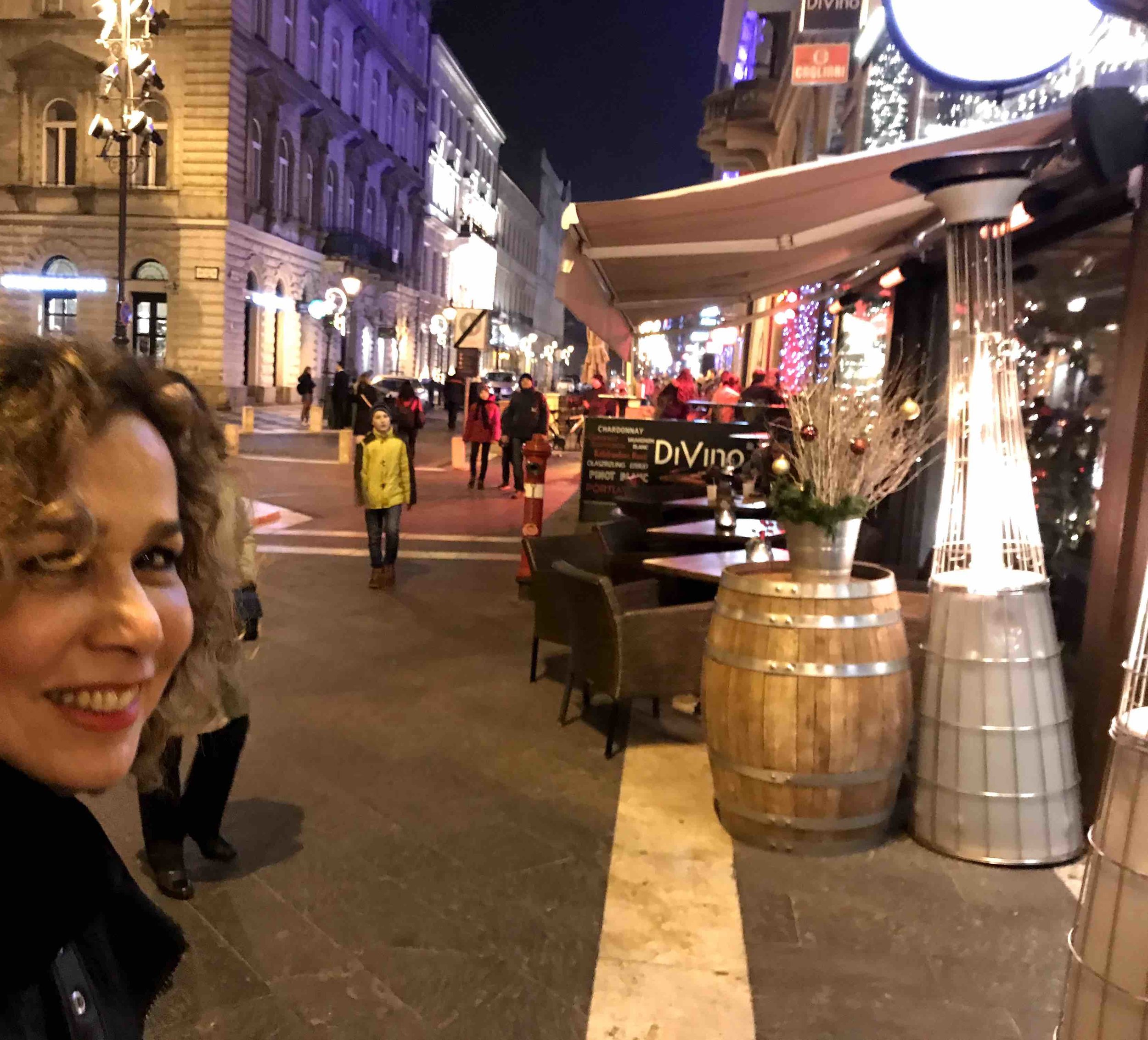If you followed my blog in Paris, you know that I love Paris for many reasons. Paris is romantic, especially at night, when the Eiffel Tower sparkles and the Louvre and the bridges of the River Seine create a lovely panorama of light. However, seeing Budapest's impressive diversity of architecture spanning the centuries, and its beautifully illuminated buildings along the Danube River and bridges that cross it made me wonder which city is more romantic at night. What do you think? Perhaps we do not have to choose, and can simply enjoy them both.
Budapest, the capital of Hungary, was once 2 cities separated by the Danube River: Buda on the hill to its west, and Pest to the east of the river, at a lower elevation. In 1873, the 2 cities merged with a third, Óbuda, to become what we now know as Budapest. It is rich in history, although not always a happy one. Today, it boasts many cultural institutions and points of interest that attract tourists from far and wide. Its noteworthy architecture from various periods reflects its history. The building styles include Gothic, Renaissance, Ottoman, Byzantine, Baroque and Classical. There is plenty for a visitor to see and do, such as visiting palaces, admiring artwork in museums, strolling among outdoor monuments, enjoying therapeutic spas in 16th-century Turkish bathhouses, going wine-tasting in wine country, and welcoming the wee hours in the city's nightclubs. Let me share with you some of the highlights from my trip. First, let's take care of business, by looking at the local property market.
REAL ESTATE IN HUNGARY
Hungary welcomes foreign investors to its residential and commercial real estate market. As an increasingly popular tourist destination, Budapest has seen a rise in housing prices, although its housing prices still lag behind neighboring capital. The Financial Times (FT) reports that Deloitte Consulting quoted the average cost of a new home in Budapest at €1,480 per square meter, compared with €2,368 in Prague and €3,999 in Vienna. The Hungarian National Bank says property prices rose by 14.6% in the first half of 2017. Although this dropped from 27% in the previous 12 months the National Bank cals this a "tapering off," and is still optimistic about growth in this sector.
Budapest offers a combination of old world and new. Depending on location, some buyers will be attracted to a hip, more bohemian ("run-down") neighborhood in Pest, while family-oriented expats and diplomats will opt for homes in Buda, which offer views from the hill, children-friendly facilities, such as playgrounds and international schools, and more natural outdoor places to roam.
HOW TO GET AROUND:
Like all major European cities, Budapest offers several options in its pubic transportation network. "The service includes buses, trolleybuses, trams, underground trains (Metro) and above-ground suburban trains (HÉV). Buses, trams and trolleybuses run daily from 4.30 a.m. until 11.0 p.m. The three Metro lines interconnect at Deák tér Station, and service frequencies range from 15 minutes late in the evening to every two minutes at peak times." Tickets must be purchased before boarding.
BUDAPEST POINTS OF INTEREST
Buda Castle
This Baroque palace, also known as the Royal Palace or the Royal Castle, was once home to Hungary's Kings. Today, the Hungarian National Gallery and The Budapest History Museum occupy the castle grounds. The castle complex, along with several buildings and monuments in the area, was designated a UNESCO World Heritage Site in 1987.
Hungarian Parliament
You cannot miss this commanding building along the Danube on the Pest side of the city. It is the largest building in Hungary and the tallest in Budapest. You can see why it is a popular tourist spot (notice the looong line cutting across the government plaza below). When it is illuminated at night, along with the bridges and other structures along the Danube, it is a magnificent part of the city landscape.
St. Stephen's Basilica
St. Stephen's Basilica is a Roman Catholic basilica, named in honor of Stephen, the first King of Hungary. Its architecture, both interior and exterior, draws many visitors.
Széchenyi Chain Bridge
This stone bridge, named for its major supporter Széchenyi lánchíd, and the huge chains that suspend it from pillars on each end, is a major landmark that connects Budapest with Pest over the Danube River. It was designed in 1839 by English engineer William Tierney Clark & Scottish engineer Adam Clark (no relation) in sections and shipped from the United Kingdom to Hungary for final construction. It opened in 1849 as the first permanent bridge in Budapest, and was one of the world's longest at that time. Blown up in 1945 near the end of World War II, with only the towers remaining, the Chain Bridge was rebuilt, and reopened in 1949. Like many others before me, I enjoyed the scenic views when I walked across it.
Shoes on the Danube Bank
I was very moved by this memorial, created by film director Can Togay and sculptor Gyula Pauer to honor the thousands of men, women & children who were killed by Arrow Cross militiamen in Budapest during World War II. The victims were ordered to take off their shoes, and were shot at the edge of the water so that their bodies fell into the river and were carried away. This memorial represents the shoes that they left behind on the river bank. Sitting on the edge of the east bank of the Danube River in front of the Parliament building are 60 pairs of rusted life-sized shoes cast out of iron. Different shoe sizes and styles from the 1940s reflect how nobody, regardless of age, gender or occupation, was spared from this brutal execution. Behind the memorial, cast iron signs declare in Hungarian, English, and Hebrew: "To the memory of the victims shot into the Danube by Arrow Cross militiamen in 1944–45. Erected 16 April 2005." Visitors place candles & flowers among the shoes.
DINING OUT
I traveled from New York City to Budapest and ended up eating at New York Café. Imagine that. Actually, Hungarians call it "New York Kávéház"), and it is one of the most opulent restaurants I have ever visited. You will feel like royalty in this dining room, with its gilded, vaulted ceilings and regal furnishings and fixtures. Constructed in 1894 by the New York Life Insurance Company, the building was completely renovated along with the Café in 2006 and reopened as the elegant New York Palace Budapest luxury hotel on the Grand Boulevard in the historic 7th District in Pest (the East side of the Danube River).
Of course, no trip to Hungary is complete without eating goulash, the hearty stew of meat & vegetables, seasoned with Hungarian paprika. If I could, I would share not only the image, but also the taste, of this delicious traditional dish with you.
Come see more of Budapest with me in this slideshow. Let's attend some shows, stroll and admire the outdoor monuments and architecture, relax at a local club, watch the ice skaters or skate with them, and enjoy a therapeutic soak in the Szechenyi Bath, the largest and most popular thermal bath in Budapest.





























